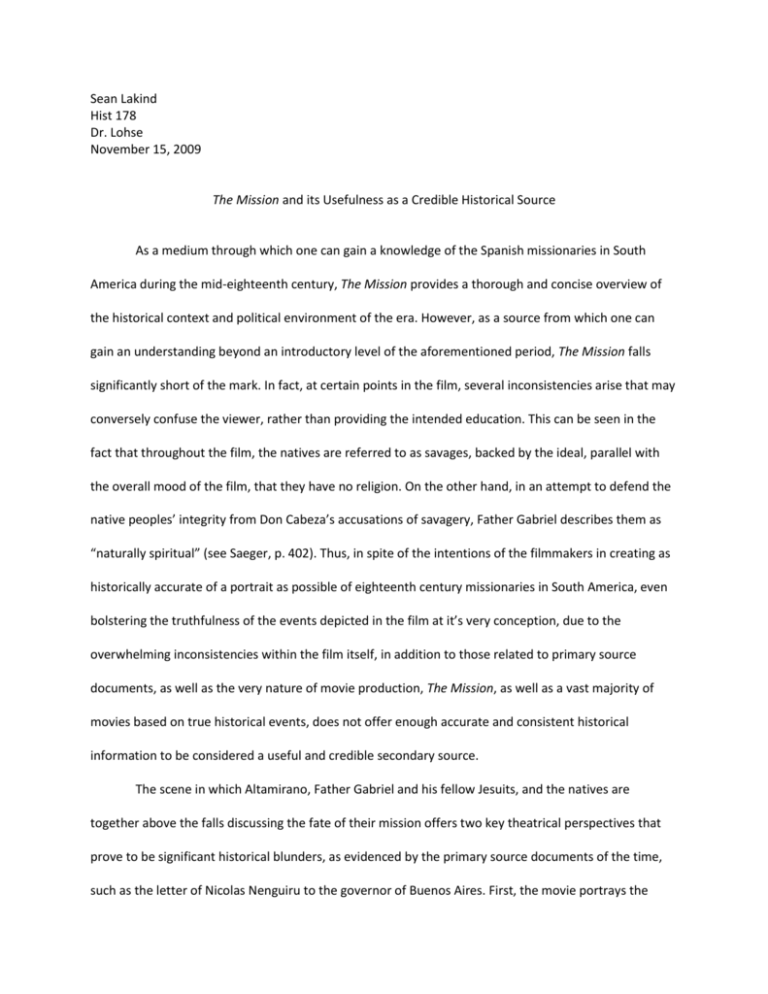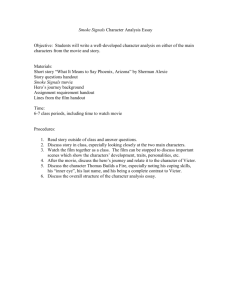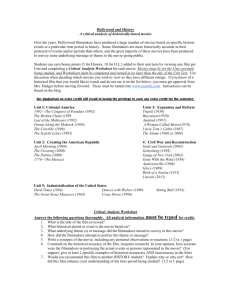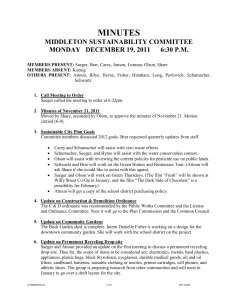Sean Lakind Hist 178 Dr. Lohse November 15, 2009 The Mission
advertisement

Sean Lakind Hist 178 Dr. Lohse November 15, 2009 The Mission and its Usefulness as a Credible Historical Source As a medium through which one can gain a knowledge of the Spanish missionaries in South America during the mid-eighteenth century, The Mission provides a thorough and concise overview of the historical context and political environment of the era. However, as a source from which one can gain an understanding beyond an introductory level of the aforementioned period, The Mission falls significantly short of the mark. In fact, at certain points in the film, several inconsistencies arise that may conversely confuse the viewer, rather than providing the intended education. This can be seen in the fact that throughout the film, the natives are referred to as savages, backed by the ideal, parallel with the overall mood of the film, that they have no religion. On the other hand, in an attempt to defend the native peoples’ integrity from Don Cabeza’s accusations of savagery, Father Gabriel describes them as “naturally spiritual” (see Saeger, p. 402). Thus, in spite of the intentions of the filmmakers in creating as historically accurate of a portrait as possible of eighteenth century missionaries in South America, even bolstering the truthfulness of the events depicted in the film at it’s very conception, due to the overwhelming inconsistencies within the film itself, in addition to those related to primary source documents, as well as the very nature of movie production, The Mission, as well as a vast majority of movies based on true historical events, does not offer enough accurate and consistent historical information to be considered a useful and credible secondary source. The scene in which Altamirano, Father Gabriel and his fellow Jesuits, and the natives are together above the falls discussing the fate of their mission offers two key theatrical perspectives that prove to be significant historical blunders, as evidenced by the primary source documents of the time, such as the letter of Nicolas Nenguiru to the governor of Buenos Aires. First, the movie portrays the discussion between Altamirano and the natives as going through the medium of Father Gabriel, as he is one of the few who understands both the native and European languages, and is certainly the most pronounced in his comprehension. However, there is a considerable amount of evidence that the natives would have been bilingual, as well, and would have not needed a translator in their diplomatic relations (Colonial Latin America, p. 309). The fact that a representative of the Guarani people thoroughly and thoughtfully penned a letter to the governor in defense of his people is representative of this fact, not only conquering the task of speaking in the European tongue, but representing a thorough and absolute understanding of European governance as well as the church, citing repeatedly the legitimacy of their settlements as endorsed by the Spanish crown, as well as the word of God. Granted, while it is improbable that the entire Guarani peoples would have spoken Spanish or understood the workings of the Spanish government, “their true words,” are represented in the letter, and in the historical context, must be taken at face value (Colonial Latin America, p. 313). As it may seem, transactions by way of letter writing may not make for the best of entertainment, but as evidenced by the primary documents of the time, the deliberation scene above the falls was simply not the case. Secondly, the movie portrays an unnatural bias by way of “Jesuit/good and Spaniard/bad,” which is just not supported by the primary sources (Saeger, p. 399). In the film, the Jesuits are strongly on the side of the natives, with little or no question as to whose efforts they are going to back. They immediately question Altamirano’s decision, and in his very presence offer resistance to his cause, guaranteeing the children that they will stay and protect them. However, in the very same letter from Nenguiru, the Jesuits, while being given credit for their support and protection in earlier years, are regarded as enemies, speaking “wrongly to persuade us to leave our pueblos and lose our well-being.” Nenguiru then continues to question their very purpose in coming to the Guarani, as it makes little sense as to why the Jesuits would have taken their grandparents from the mountains, to “congregate and teach them just to send them away now” (Colonial Latin America, p. 312). While this does not wholly condemn the Jesuits present in the mission as enemies of the Guarani, it certainly does deflate their apparent steadfast and true nature as presented in the movie. In light of the overwhelming evidence against the historical accuracy of the film, Saeger’s article offers several contrasting, perhaps even unfounded, criticisms of the movie, which ultimately poke the proverbial holes in his argument. Almost immediately, Saeger reviles the movie for its vast ethnocentrism, as “Native Americans appear throughout, but no Indian viewpoint emerges, even though creating three-dimensional Guaranis is as easy for film makers as it is difficult for historians” (Saeger p. 394). In this conception, Saeger scrutinizes the film-makers for not creating more of a Guarani-based viewpoint. However, as Saeger notes, it is nearly impossible for historians, even those whose entire lives are devoted to studying and understanding these cultures, to do so. Thus, by encouraging filmmakers, who are most likely uneducated in the field other than a brief introductory knowledge, the end result of a Guarani viewpoint would be, at best, speculative, and at worst, complete guesswork. The idea that Saeger is here promoting the very concept that he is vilifying is completely detrimental to his argument, leading to confusion and disorder amongst his following assertions. Saeger also references a line from the very beginning of the movie where Altamirano is dictating a letter to a scribe, saying “the Indians are once more free to be enslaved by the Spanish and Portuguese settlers,” in an effort to convey the “ideological confusion” apparent in the film (Saeger, p. 395). However, this line delivered by Altamirano is never recorded in the letter, and is even retracted upon when he states that it was not “hitting the right note,” as he begins his dictation completely anew. Instead, he focuses on the ingenious nature of the natives, taking to music and the gospel in manners fit for Rome, supported by the proclamation issued in the first lines of Altamirano that some of the music in Rome was, in fact, performed by natives of South America. Whether this is true or not is not the matter at hand. Instead, the usage of the line immediately dismissed, even by the movie itself, does not make for a sound argument for the “ideological confusion” evident in the movie; instead, it offers dramatic effect, and little more. By this, it is apparent that The Mission, and movies like it, should not be taken at face value, and are not efficient learning tools by which to understand the nature of history. Specifically to the perception of South American Jesuit missions, the Mission falls quite short of being wholly historically accurate, but such is the nature of feature films. While the filmmaker’s immediate intentions might be to create as accurate of a portrayal as possible of the intended subject matter, the fact is that there are too many variables in movie production that can and will cause the film to drift from its anticipated course. Things such as the unique character portrayal by the actors in their own vision of the story, engaging dialogue added by writers and editors, and scenes removed and added by producers and production companies to ensure the overall entertainment of their audience all account for means by which the historical accuracy of a film can be diminished, often quite rapidly. Ultimately, it is imperative to remember the primary goal of producing a film: to make money. In order to do so, filmmakers are required to make their projects sufficiently entertaining, and when historical events and progressions do not offer the entertainment sufficient enough to engage an audience, filmmakers are required to fill in the gaps with their own creations, thus skewing the historical accuracy of the project. Thus, The Mission, in spite of its flaws, can be seen as an excellent and engaging educational tool to be used by, perhaps, high school and introductory college level courses, in order to provide a brief but thorough overview of the situation affecting the South American missions in the 1750’s. However, to be used as more than that, whether as a source for a scholarly paper, article, book, or otherwise, would be completely irrational, as the sources and information available to the modern scholar, whether primary or secondary, are far more informative and determinative than two hours worth of artificial dialogue, and bare undertones of historiography.






